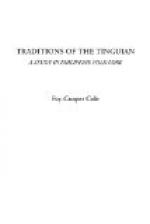Revenge for the loss of relations or townspeople is a potent cause of hostile raids; old feuds may be revived by taunts; but the chief incentive appears to be the desire for renown, to be known as “a man who goes to fight in the enemies’ towns” (pp. 90, 59).
Warriors sometimes go in parties, sometimes alone, but generally in couples (p. 67). At times they lie in ambush and kill young girls who go for water, or old men and women who pass their hiding place (p. 97). Again they go out boldly, armed with shield, spear, and headaxe; they strike their shields as they go and announce their presence to the enemy (p. 103). In five of the tales the heroes challenge their opponents and then refuse to be the first to use their weapons. It is only when their foes have tried in vain to injure them that they enter the conflict. In such cases whole towns are wiped out of existence and a great number of heads and a quantity of jars and other booty is sent back to the towns of the victors (p. 104). Peace is restored in one instance by the payment of a number of valuable jars (p. 91).
Upon the return of a successful war party, the relatives meet them at the gate of the town and compel them to climb the sangap; [10] then invitations are sent out to friends and relatives in neighboring towns to come and aid in the celebration of the victory (p. 140). When they arrive at the entrance of the village they are met by the townspeople, who offer them liquor and then conduct them to the houses where they feast and dance to the music of gansas (p. 126). [11] Finally the captured heads are stuck on the sagang [12] and are placed by the gate, the spring, and, if sufficient in number, surround the town (p. 140). Taking the heads of one’s neighbors does not appear to be common, yet cases are mentioned where visitors are treacherously killed at a dance (pp. 78, 83).




